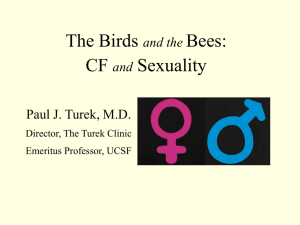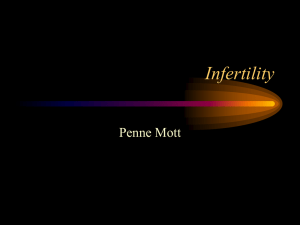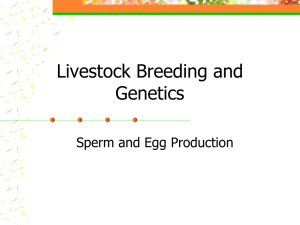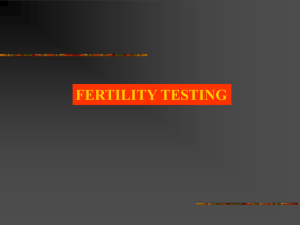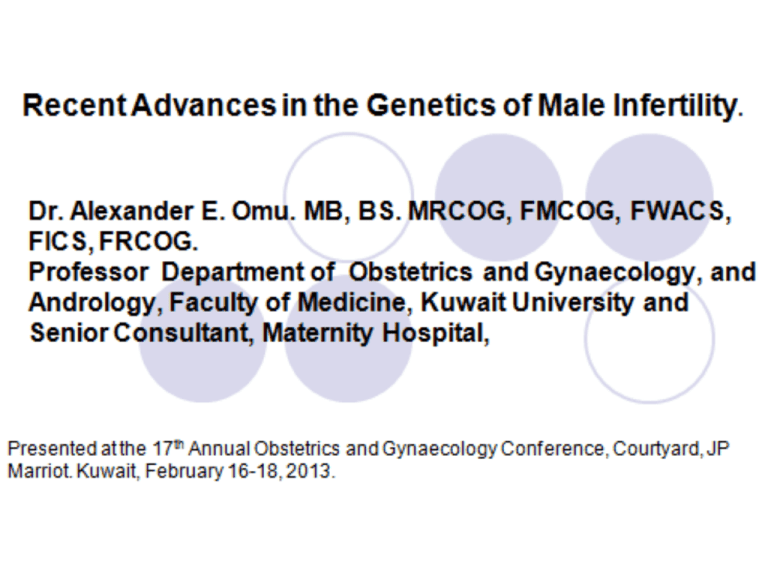
OUTLINE
1. Genetic abnormalities associated with male infertility
2. Advances in Genetic testing in male infertility
3. Genetc Counseling
4.
Genetics of Development and Potential contribution to
Male Infertility.
4.
Role of Epigenetics- RNAs
5.
Future directions
What is male infertility?
* Inability to achieve conception after 12 months or more of
trying to achieve conception.
How common? 10-18%.
*Male infertility is found to have a role in approximately
50% of infertile couples.
*Infertility is considered as an important national problem
concerning reproductive health.
1 photo
My scientific studies have afforded me great
gratification; and I am convinced that it will not
be long before the whole world acknowledges the
results of my work.
Gregor Mendel
Is the next Medical breakthrough in Genetics?
Facts Check
*Our ability to treat men with severe male infertility has far
surpassed our understanding of its causes
*Advances in molecular biology, genetics and technology is
gradually increasing interest in genetic cause of male infertility.
•Almost 20% of men with azoospermia or severe oligospermia
have an identifiable genetic cause for male infertility.
*Gene expression determines cell function and Genes that control
sperm production. and it can be regulated in a variety of ways.
•Genetic diseases can be passed on to children since ICSI
bypasses the natural selection process.
Chromosomal Abnormalities
Occurs in 16% of men with Azoospermia
Klinefelter syndrome (13%)
* Frequency of 1:500–1:1000 of live deliveries
* X chromosome polysomy with X disomy (47,XXY)- 90% and various mosaicism 10%
*Tall eunuchoid body proportions, low testosterone, sparse facial and pubic hair, small hard
testicles, micropenis, sterility, and moderate cognitive deficits. erectile dysfunction, poor libido
•Men with mosaicism are less affected and often are not diagnosed. Advanced maternal age and
possibly paternal age have been linked to increased risk of Klinefelter syndrome
Mechanism
Non-disjunction at mitosis
Maiburg M, Repping S, Giltay J. The genetic origin of Klinefelter syndrome and its effect on
Spermatogenesis. Fertil Steril. 2012; 98: 253-60
*
.
Spermatogenesis in Klinefelter Syndrome and Treatment of infertility
1.
Men with KS are not always sterile. In some of these patients sperm can be found
in semen or in the testis, but the proportion of sperm aneuploidy is high. Signs of
hypoandrogenism seem to be associated with low sperm recovery rate.
2. ICSI
Selice R, Di Mambro A, Garolla A, Ficarra V Iafrate M, Ferlin A, Foresta C
Spermatogenesis in Klinefelter syndrome. J Endocrinol Invest. 2010 ; 33: 789-93.
Oates RD. The natural history of endocrine function and spermatogenesis in Klinefelter
syndrome: what the data show Fertil Steril 2012 ; 98: 266-73.
New Concepts
*Adolescents with KS have spermatogonia has stimulated interest
Advancements in artificial reproductive techniques and the successful
delivery of healthy children
*Sperm can be found in over 50% of men with Klinefelter syndrome,
thus men with Klinefelter syndrome are not sterile, born with
spermatogonia and lose large numbers of germ cells during puberty.
•Early diagnosis and treatment can improve the quality of life and the
overall health of men with KS
Paduch D A, Fine, R G. Bolyakov A, Kiper J, New Concepts in
Klinefelter Syndrome.Current Opinion in Urology 2008, 18:621–627
Y Chromosome Microdeletion (YCM).
Macroscopic deletions in the long
arm of Y chromosome were
suggested to be responsible for
azoospermia
(Tiepolo and Zuffardi, 1976).
In 1994 Lilford et al. proposed that
human male subfertility, related to
oligoasthenoteratospermia, has a
familial component
(Lilford et al., 1994).
Vogt et a.2003, Skaletsky et al 2003
Palindromic structure of the Y chromosome.
Each palindrome consists of a set of amplicons that is repeated
reversely. Thus, the palindrome reads the same in either direction. In
addition to the palindromes, there are 5 sets of amplicons that are
widely spaced inverted repeats (IRs) with small lengths.
Skaletsky H, Kuroda-Kawaguchi T, Minx PJ, et al. The male-specific
region of the human Y chromosome is a mosaic of discrete sequence
classes. Nature. 2003;423:825-37.
Y Chromosome microdeletion
Skaletsky H, Kuroda-Kawaguchi T, Minx PJ, et al. The male-specific
region of the human Y chromosome is a mosaic of discrete sequence
classes. Nature. 2003;423:825-37.
Clinical implications of Y Chromosome Microdeletions
Level
TESE
ICSI
Risks
Failure with some AZF deletions
Unsuccessful fertilization
Selection of poor-quality spermatozoa
Pregnancy
Poor embryo quality
Pregnancy loss
Offspring
Transmission of YCM of father
De novo abnormalities
Y microdeletions
Expanded Y microdeletion of father
Karyotypic anomalies (nullisomy/trisomy)
Yet unknown abnormalities in adulthood
AZFc microdeletions significantly more frequent in men from couples
with recurrent pregnancy loss than in fertile and infertile men.
Proximal AZFc region might play an role in maintaining gestation.
Sadeghi-Nejad H, Farrokhi F. Genetics of azoospermia: current knowledge, clinical implications,
and future directions. Part I. Urol J. 2006;3:193-203.
Y Chromosome Microdeletions Worldwide.
Microdeletions have been reported to occur in fertile men of 2% but in 5% to 10%
of infertile men, in 2% to 3% of the candidates for ICSI, 6% to 16% of azoospermic
men, and 4 to 5% with severe oligospermia.
Limited studies in the Middle East; YCMs were reported in 3.2% with azoospermia
or oligospermia in Saudi Arabia, in 3.3% in Turkey and in 2.6% in Kuwait.
China 9.2% of subfertile men had AZF microdeletions and 8.5% had chromosomal
abnormalities and in India, genetic factors contribute 15%-30% of male infertility.
Worldwide, 5% to 24.2% of infertile men with idiopathic severe spermatogenesis
impairment had these genetic aberrations.
Sadeghi-Nejad and Farrokhi . J. Urol 2007;4: 193-203
Zhang et al , Male infertility in Northeast China: J Assist Reprod Genet. 2012; 29:
Shamsi et al Genetic and epigenetic factors: Role in male infertility. Indian J Urol 2011;27:110-20
CFTR gene mutations and Congenital absence of the vas deferens (CAVD)
*Mutation in CFTR gene cause CBAVD. Prevalence 1%
*Common cause of azoospermia, low semen volume and acidic pH.
*Normal testicular sperm, immotile due to absence of vas deferens,
epididymis and seminal vesicle.
*80% of men with CBAVD have at least one allele mutated in CFTR.
*Most common CFTR mutation is a three base paired deletion at
position 508 that causes deletion of phenylalanine >Delta F508 CFTR
*Congenital unilateral absence of the vas deferens. Rarely presents with
infertility. CFTR gene mutation in 43% in those men affected.
Riordan et al Identification of the cystic fibrosis gene: cloning and characterization of complement. Science. 1989 Sep 8;245:1066-73.
Li et al. Mutationn in the cystic fibrosis transmembrane conductance regulator (CFTR) in Chinese patients with congenital bilateral absence of
vas deferens. J Cyst Fibros. 2012;11:316-23.
Where is the CFTR gene located?
Cytogenetic Location: 7q31.2
Molecular Location on chromosome 7: base pairs 117,120,016 to 117,308,718
The CFTR gene is located on the long (q) arm of chromosome 7 at position 31.2.
More precisely, the CFTR gene is located from base pair 117,120,016 to base pair 117,308,718 on chromosome 7.
Ghorbel et al. Screening of ΔF508 mutation and IVS8-poly T polymorphism in CFTR gene in Tunisian infertile men without CBAVD.
Andrologia. 2012; 44 Suppl 1:376-82.
Animation of simple CFTR channel activity.
Cystic fibrosis (CF) was first recognised over 400 years in Germany and is
Animation of simple CFTR
channel activity.
Cystic fibrosis (CF) was first recognised over 400 years in Germany and
is
Figure 3: The deltaF508 deletion is the most common cause of cystic
fibrosis. The isoleucine (Ile) at amino acid position 507 remains
unchanged because both ATC and ATT code for isoleucine
Dinić J, Kusić J Nikolić A Divac A Ristanović M Ra dojkovic D. Analysis of Y chromosome microdeletions and CFTR gene mutations as genetic markers of
infertility in Serbian men.. Vojnosanit Pregl.2007; 64: 253-6.
Effects of CFTR mutation and need for Counseling
*Several diseases: cystic fibrosis (CF) and renal malformation.
*65% have a detectable mutation in one of the cystic fibrosis genes and
15% will have a missing or misplaced kidney
*A carrier of CFTR gene. If his wife is also a carrier then there is a 25%
chance of a child born to them having CF.
*All men with CAVD and/or their wives have genetic screening for CF
gene mutations prior to undergoing In-Vitro Fertilization.
*Sperm can be successfully harvested from these men by microsurgical
epididymal sperm aspiration (MESA). The sperm can then be used to
fertilize an egg and establish a pregnancy.
O'Flynn O'Brien KL, Varghese AC Agarwal A The genetic causes of male factor infertility: a review. Fertil Steril 2010 Jan;93(1):1-12.
Autosomal Robertsonian and reciprocal translocation. Breaks in two
chromosomes and abnormal repair of the chromosomal fragments resulting in the
transposition of genetic material from one chromosome to another without the loss of any
genetic material
In a recent study, sperm from men with severe O-A-T were found to
have higher frequency of aneuploidy and diploidy.
A number of rare genetic conditions
in men with infertility:
Kennedy’s disease,
Kallman Syndrome,
Prader Will syndrome,
myotonic dystrophy
Kartagener syndrome
Harton G L and Tempest H G . Chromosomal disorders and male infertility. Asian Journal of Andrology 2012; 14 : 32-39
X Chromosome and Male Infertility
• That X chromosome is important in mammalian spermatogenesis is suggested by its
enrichment of germ cell-specific genes expressed in spermatogenesis
:
* AR, USP26, TAF7L, testis-expressed gene 11 (TEX11), KAL1, AA-kinase anchor
protein 4 (KAP4), and), nuclear RNA export factor 2 (NXF2) and TBP-associated
factor 7l (Taf7l), genes on the X Chr. Have roles in the regulation of male fertility
• Knock-out mice models in which X-linked genes have been shown to alter
spermatogenesis, and on genes that have been studied in humans.
* Function not understood and deserves further characterization.
Stouffs K, Lissens W. X chromosomal mutations and spermatogenic failure. Biochim
Biophys Acta. 2012; 1822(12):1864-72.
. Shi Y, Wei L, Cui YX, Huang YF. Zhong Nan Ke Xue.2010;16: 460-7.
Zheng et al. Regulation of male fertility by X-linked genes. J Androl. 2010 ;31;79-85
Genetic testing methodologies
*Clinical Evaluation including semen analysis
Genetic assessment of infertile males.
*Karyotype analysis,
*Sperm fluorescence in situ hybridization (FISH)
*PCR-based testing for Y-chromosomal evaluation, neucleotide level.
* Two-dimensional polyacrylamide gel electrophoresis (2D-PAGE)
* Liquid chromatography–mass spectrometry (LC–MS)/MS,
* High-resolution microarrays for chromosome screening and
* Microchip devices for electrophoresis
*Sperm DNA fragmentation:
Flow cytometry- Sperm Chromatin Structure Assay
miRNA analysis, Genome Wide Association Studies
(GWAS) and array comparative genomic
hybridisation (CGH) studies.
Pastuszak AW Lamb DJ. J. Androl. 2012 Aug 9. [Epub ahead of print
Mark A Baker. Asian Journal of Andrology 2011; 13, 6–10.
Evenson DP, Jost LK, Marshall D, et al. (1999) Utility of the sperm chromatin structure assay.
Hum Reprod 14:1039–1049
ASSESSMENT OF SPERM DNA DAMAGE
1. The SCSA is based on the phenomenon that
chromatin with DNA strand breaks has a tendency to
become denatured when exposed to an acid–detergent,
whereas normal chromatin remains stable. AO is a
metachromatic dye that differentially stains double- and
single-stranded nucleic acids. AO molecules intercalate
into the intact (double-stranded) DNA emit a green
fluorescence, but AO molecules bound to denatured
(single-stranded) DNA emit a red fluorescence. DFI :
the ratio of red to total (red plus green) fluorescence
intensity, represents the proportion of cells containing
denatured DNA.
2.Comet Assay. The Single Cell Gel
Electrophoresis assay is an uncomplicated and
sensitive technique for the detection of DNA
damage at the level of the individual
eukaryotic cell. It was first described by Singh
et al. in 1988. It has since gained in popularity
as a standard technique for evaluation of DNA
damage/repair, biomonitoring and genotoxicity
testing.
Evenson DP, Jost LK, Marshall D, et al.
(1999) Utility of the sperm chromatin
structure assay. Hum Reprod 14:1039–1049.
Sperm proteomics
Sperm proteomics is the identification and functional study of sperm
proteins. Identification and cataloging of thousands of sperm proteins.
A recent study compared asthenozoospermia vs normozoospermic men
; identified 75 different sperm proteins, Comparative proteome analysis
revealed eight sperm proteins with either increased or decreased
frequency in the asthenozoospermic samples.
Three functional groups:
1.Proteins involved in sperm energy and metabolism,
2.Sperm movement and organization
3.Protein turnover, folding and stress response.
Kashou et al. The Advent of Sperm Proteomics has Arrived. The Open Reprod Science Journal
2011; 3: 92-97
Tomar et al Differential proteomics of human seminal plasma: A potential target for searching
male infertility marker proteins. PROTEOMICS - Clinical Applications 2012; 6: 147–151,
Siva et al. Proteomics-based study on asthenozoospermia: differential expression of proteasome
alpha complex. Mol Hum Reprod 2010; 16: 452-462.
The role of genetic counselling
1. In CFTR Testing for both couple-25% CF
2. In YCM, the decision to proceed with ICSI
* Knowledge that male offspring will be infertile by definition.
A thorough genetic consultation should be offered and the
physician should confirm the couples’ understanding of the
potential risks to their child. In such cases, sex selection by
preimplantation genetic diagnosis assays and female embryo
selection is an option for some couples.
** Giltay et al 1998 and colleagues showed that more than half of the
patients who tested positive for chromosomal aberrations decided to
go ahead with ICSI.
Nap et al Reproductive decisions of men with microdeletions of the Y chromosome: the role of genetic
counselling. Human Reprod 1999;14: 2166-2169
Giltay, J.C., Kastrop, P.M.M., Tuerlings, J.H.A.M. et al. (1999) Subfertile men with constitutive chromosome
abnormalities do not necessarily refrain from intracytoplasmic sperm injection treatment: a follow-up study
on 75 Dutch patients. Hum. Reprod., 14, 318–320.
Future of Understanding of Male Infertility
* Primary sex development
• Spermatogenesis
• Capacitation
• Acrosome Reaction
• Sperm-Oocyte interaction
• Fertilisation
• Pre-implantation development
Brugh et al. Male factor infertility: Med Clin North Am. 2004; 88: 367-85
*Spermatogenesis: Testis, seminiferous tubules, epididymis, vas deferens, prostate and
urethra). As the sperm travel, seminal fluid is added from the seminal vesicles, prostate, testis
and epididymis and periurethral glands. The function of the ejaculate transport sperm into the
female genital tract and provide a suitable environment for sperm survival during this transit.
Roberts M, Jarvi K, Can Urol Assoc J. 2009; 3: 479-85.
*Fertile sperm in vivo, undergoes capacitation, traverses the cervical mucus and reach the ova,
and the acrosome reaction, fuse with the oolemma, and incorporate into the ooplasm. Proper
embryo development requires that functional DNA be delivered to the ooplasm. Defects in any
of these steps may result in infertility.
Sigman et al. Semin Reprod Med. 2009; ;27 :115-23.
FIG. 2. Summary of genetic pathways involved in gonadal development
Park, S. Y. et al. Endocrinology 2005;146:1035-1042
Copyright ©2005 The Endocrine Society
Sperm-Oocyte Interactions
Janice P. Evans. Sperm-Egg Interaction Annual Review of Physiology 2012;. 74: 477-502.
Naokazu Inoue, Masahito Ikawa and Masaru Okabe. The mechanism of sperm–egg interaction and the involvement of IZUMO1 in
fusion Asian Journal of Andrology (2011) 13, 81–87;
Recent gene knockout approaches in animals about Fertilisation
*Sperm from 6 different gene-disrupted mouse lines (calmegin
(Clgn), Adam1a, Adam2, Adam3, and Ace) and testis-specific
molecular chaperone, calsperin (Calr3), all have defective zonabinding ability and oviduct-migrating ability.
* Sperm- Oocyte fusion.
Sperm require IZUMO1 and eggs require CD9 for sperm-egg
fusion.
Muro and Okabe. J. Androl 2010
Cocuzza et al. Int Br J. Urol 2007
Biology and Genetics of RNA
Mouse models of male reproductive defects provide new insights into the causes of male infertility.
•Jump to main content
•
Matzuk M M & Lamb D J. The biology of infertility: research advances and clinical challenges
Nature Medicine 2008; 14, 1197 – 1213.
CONCLUSION(S):
Implicated role of gross genomic rearrangements in male
infertility; aneuploidy, translocations, Y chromosome deletions,
and DNA damage
X-linked genes have been shown to alter spermatogenesis,
more elucidation and gene characterisation are needed
Analysis of the genetic factors that impact male fertility leads
to better understanding of genetic causes of male infertility.
Counseling should be an integral component of management
Novel technologies will lead to identify specific biomarkers MI
New research areas: miRNA analysis, Genome Wide Association
Studies (GWAS) and array comparative genomic hybridisation (CGH)
Signpost development of new therapeutic agents e.g Contraceptives
THANK YOU


